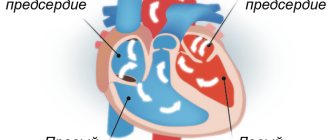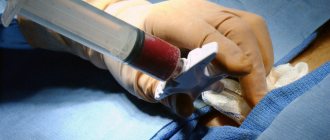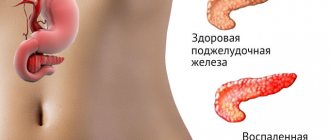All women are different, and each woman also has her own external characteristics of the mammary glands. Therefore, clearly visible veins on the chest do not always indicate a disease. The cause of this phenomenon can be menstruation, sudden weight loss, or a serious emotional outburst. But it’s still better to play it safe, and if protruding vessels cause even the slightest discomfort, consult a doctor. What you should be wary of, what diseases are indicated by visible vessels on the chest, and what measures can be taken - you will learn from this article.
Features of the female body and mammary glands
A woman's chest is riddled with many blood vessels. As a rule, they are not visible or are slightly translucent, but there are also situations when the veins on the mammary gland appear very noticeably. The woman begins to worry and search for a reason, which is quite normal.
The phenomenon of protruding veins on the chest is individual in nature. It can manifest itself to varying degrees in different women. This is due to hormonal fluctuations, a specific ailment, or even body type. It is almost impossible to find out on your own what caused it. To properly diagnose and solve the problem, it is best to consult a doctor.
Do not forget that for some, veins visible on the chest are quite normal. For example, in girls with a pale skin tone and fragile physique, they will shine through, regardless of the presence of diseases, medications and other factors. You only need to worry if the changes are really noticeable, and in addition to the veins, there is also obvious discomfort in the chest area.
Signs of the first and second pregnancy
Are the early signs of the first and second pregnancy different? We answer: everything is purely individual. There are many cases where the same woman’s first pregnancy occurred against the background of severe toxicosis, while bearing a second child did not cause any problems.
In general, gynecologists identify the same early signs of pregnancy, regardless of whether it is the first, second or third. However, pathologies such as hemorrhoids and varicose veins during the second and subsequent pregnancies become aggravated already in the first weeks of gestation.
Why do veins appear?
The reasons may vary. Including those that are completely harmless and have nothing to do with health. For example, you have suddenly lost weight. As a result of losing kilograms in a short time, the fat layer thins out and blood vessels become more visible. When the figure returns to its previous parameters, the veins that bother you will also disappear.
The answer to the question of why veins are very visible on the chest may be associated with excessive physical activity. After you have been involved in hard work or intense sports, veins may appear not only on the arms and legs, but also on the mammary glands. You just need to give the body a rest - and the blood vessels will return to normal.
The cause may also be sudden emotional changes. For example, you have experienced severe stress or, conversely, a huge surge of joyful emotions. This naturally causes blood flow to the vessels, which makes the veins appear more visible on the skin.
Certain hormonal medications can also cause vascular dysfunction. Many of them have an unpleasant side effect - they contribute to blood thickening, hence the visible veins.
In teenage girls, during breast formation, a restructuring of all body systems occurs. The skin does not always have time to adapt to rapid changes, so it becomes stretched and thinner.
In adult women, veins may be visible shortly before the start of the period. This may be accompanied by swelling of the mammary glands and some discomfort. These symptoms should not alarm you: from the very first days of menstruation, your breasts will return to normal.
Finally, many women notice the appearance of veins on their breasts during pregnancy. This is considered one of the main symptoms of an “interesting situation.” The reason is simple: the body automatically begins to prepare for motherhood, and this process begins with the mammary glands. The breasts may not only acquire translucent vessels, but also swell, acquire excessive sensitivity, and the nipples may change color and even shape.
In addition to these harmless signs, the appearance of visible veins on the chest can also signal health problems. If you have even the slightest doubt, try to see a doctor as soon as possible.
External signs of pregnancy
A change in a woman’s appearance already in the early stages may indicate pregnancy.
Acne during pregnancy
A sharp hormonal change in the body of a pregnant woman and increased activity of the sebaceous glands can trigger the appearance of acne, even if the woman has not previously encountered this problem.
Most often, the rash goes away after the baby is born and does not require any treatment.
If a pregnant woman decides to deal with rashes before delivery, then she should remember that during this period it is forbidden to use drugs that contain retinoids and salicylic acid. In addition, removal of rashes using laser, deep peeling, or mechanical cleaning is contraindicated. Phytotherapeutic procedures should also be treated with caution.
Facial redness during pregnancy
Such an early sign of pregnancy as facial redness is associated not only with hormonal levels, but also with increased blood circulation during this period.
Many pregnant women experience the so-called “pregnant mask”, which is characterized by the appearance of age spots localized in the forehead, cheeks and nose. You should not be afraid of such spots, since after childbirth they will go away on their own over time.
Veins during pregnancy
The onset of pregnancy may be marked by the appearance of venous patterns (or spider veins) on the chest, neck, arms and legs. Such spider-like patterns of dark red or bluish color, like skin pigmentation, will disappear on their own with the birth of the child.
Edema during pregnancy
In the early stages of pregnancy, slight puffiness of the face may be observed. In addition, your hands may swell, which is especially noticeable if you clench your hand into a fist.
It should be remembered that swelling in the first months of bearing a child is not normal and may indicate that the expectant mother has kidney disease or cardiovascular disease. Therefore, if this symptom appears, you should consult a doctor.
Breast enlargement during pregnancy
Many women, due to the absence of menstruation, may suspect pregnancy in the first weeks of conception due to breast enlargement by 1 - 2 sizes. Moreover, this sign can be observed even if a woman loses her appetite and loses weight.
Breast enlargement may be accompanied by pain and tingling in both mammary glands.
Important! During pregnancy, both breasts increase in size exactly the same. Enlargement of one mammary gland or any part of it should alert you, as it may signal the presence of serious diseases.
Nipple changes during pregnancy
Early signs of pregnancy are darkening and swelling of the nipples, as well as the appearance of Montgomery tubercles - small outgrowths localized in the nipple area. Outwardly, such formations resemble small warts that are filled with a sebaceous substance.
There is no need to worry about the appearance of such tubercles, since they in no way disrupt the functioning of the sebaceous glands and do not affect the health of the expectant mother, much less the fetus.
Pain and burning sensations that occur when touching the nipples may also indicate pregnancy.
Discharge from the breast during pregnancy
An early (albeit rare) sign of conception may be clear fluid released from the nipple when pressure is applied to it.
Sometimes, in early pregnancy, colostrum may begin to be released, which indicates galactorrhea, a condition in which there is increased production of the hormone prolactin.
In general, the appearance of colostrum is more typical in the second and third trimesters of pregnancy.
Stripe on the stomach during pregnancy
Many people believe that a brown line on the abdomen, running from the navel down, appears in late pregnancy. In fact, this line can be seen already in the first weeks of pregnancy, it will simply be white, whereas from the 12th week it will begin to acquire a brown tint.
Veins during pregnancy
Very often, blood vessels on the breasts become more visible in pregnant women. There is no need to worry: this is a completely normal condition. Your breasts begin to prepare for motherhood and future feeding. The milk ducts expand and begin preparing for the passage of milk masses. All this leads not only to swelling and an increase in the size of the mammary glands, but also to a change in the structure of blood vessels. As a result, they become noticeable and may even appear above the skin.
If your breasts cause obvious discomfort during lactation or during pregnancy, do not delay your visit to a mammologist. He will check the mammary glands for the presence of tumors and help diagnose the disease in the early stages.
Diagnostic measures
A mammologist and phlebologist will help you cope with breast problems. Before prescribing treatment, a series of medical examinations are carried out. Timely diagnostic measures are necessary for an accurate diagnosis and prescription of the necessary therapy. Diagnosis of breast disorders includes the following steps:
- Collecting anamnesis of life and illness.
- Visual examination of the breast.
- Palpation of the mammary glands.
- Ultrasonography.
- Ductography.
- Sonography.
- Histological examination of identified neoplasms (if necessary).
- Complete blood test to determine the level of hormones in the blood.
- Blood test for the presence of inflammatory processes in the body.
During the examination, the specialist analyzes the accompanying symptoms of the disease, evaluates the external features of the chest and mammary glands, pays attention to the nipples and discharge from them. In some cases, the patient may be referred to a surgeon-oncologist.
Veins in the second and third trimester of pregnancy
At this stage, swelling and an increase in the volume of the veins is normal - after all, they have to supply blood not only to your own body, but also to the body of the growing baby. Vessels become visible not only on the chest, but also on the legs. After childbirth, they disappear in the vast majority of women.
Every fifth pregnant woman faces such an unpleasant problem as varicose veins. The vessels swell very strongly and protrude above the surface of the skin. This can become noticeable already at the beginning of pregnancy, and only worsen towards the end of it - because the uterus begins to squeeze the veins more strongly, and the flow of blood to the lower extremities becomes difficult.
Signs of pregnancy while breastfeeding
Many women mistakenly believe that it is impossible to get pregnant while breastfeeding. This is wrong.
Let's look at the signs that may indicate that a nursing mother is pregnant again.
If your baby refuses to breastfeed for no apparent reason, consider purchasing a pregnancy test. The fact is that a new pregnancy provokes a change in the taste of breast milk, which acquires a bitter taste and becomes less sweet.
The consistency of the milk itself may change, as well as its quantity (up to its complete disappearance).
You should also pay attention to persistent hypersensitivity, as well as soreness of the nipples, especially if such signs were not previously observed during breastfeeding.
Darkening of the skin around the nipples may also indicate pregnancy.
The absence of menstruation, provided that it has already occurred after childbirth, can also be a sign of pregnancy.
What if the veins did not disappear after childbirth?
Veins on the breasts are common in early pregnancy, but sometimes they remain even after the baby is born. Of course, there is little good in this, and the woman has to experience aesthetic and sometimes physical discomfort. But modern medicine can easily cope with this problem. There are two procedures that can be used to get rid of veins on the chest.
Diagnosis of varicose veins
At the appointment, the phlebologist performs a visual examination of the patient. An experienced specialist will recognize varicose veins at the earliest stages.
During diagnostic procedures, the doctor establishes or excludes the presence of varicose veins, then he determines the nosological variant of chronic venous disease and determines treatment strategies. It is at the stage of determining the treatment strategy that the doctor decides which methods are suitable for correcting varicose veins of the extremities - whether it is possible to limit ourselves to conservative non-surgical methods, or whether only surgical methods of treating varicose veins are possible.
Next, the treatment tactics are determined - is it possible to treat with one technique or is a combination of several techniques better suited for the treatment of varicose veins. At the final stage, the doctor objectively evaluates the effectiveness of treatment procedures.
Methods for diagnosing varicose veins of the lower extremities
:
In addition to the traditional history taking, examination and palpation in modern medicine, the diagnosis of diseases of the veins of the lower extremities is carried out using ultrasound angioscanning - USAS.
Ultrasound angioscanning is a modern express method that allows you to diagnose the condition of veins and arteries and can determine signs of venous reflux (backflow of blood from the deep superficial vein).
Ultrasound ultrasound is the most basic method for diagnosing varicose veins of the lower extremities.
Next, the doctor determines the treatment strategy for the disease. Modern methods of treating varicose veins of the lower extremities allow the procedure to be carried out painlessly and absolutely safely.
Remember that you absolutely cannot prolong the course of the disease, since varicose veins can cause all sorts of complications.
Laser therapy
This measure is considered the most successful method of combating venous diseases to date. The laser, as if by magic, destroys all small blood vessels without damaging the skin. As a rule, after one session of laser therapy the result will be visible; in some cases the procedure is repeated.
Laser therapy is absolutely safe and does not cause any pain. In rare cases, complications occur, for example, burns may appear. But there will be no bruises or swelling, like from sclerotherapy.
Treatment methods for varicose veins of the lower extremities
There are various methods for treating varicose veins - surgical intervention, conservative methods (compression therapy, medication, physiotherapy) and modern non-surgical methods such as laser treatment, radiofrequency ablation of veins, sclerotherapy, phlebectomy.
1. Operation
Traditional surgery today is rarely prescribed and for certain indications. First of all, this is explained by the fact that the removal of a vein itself is accompanied by significant trauma, the possible appearance of hematomas, a long postoperative period and prolonged pain.
2. Conservative treatment
Depending on the stage and severity of the venous disease, one or another type of treatment is selected. Conservative treatment methods are required at any stage of the disease - as additional therapy or as primary therapy, depending on the degree of damage to the blood vessels. Conservative treatment methods include physical therapy, compression treatment of varicose veins and drug treatment of varicose veins of the lower extremities.
2.1. Physiotherapy
This method involves performing pressotherapy. This procedure is aimed at removing excess fluid from the lower extremities, formed against the background of chronic venous insufficiency and initial venous edema.
Like any other conservative method, physiotherapy does not imply the elimination of affected vessels and their areas; it reduces the manifestation of varicose veins. With the help of physiotherapy, venous and lymphatic outflows are improved, microcirculation is improved, and discomfort in the lower extremities, such as pain and cramps in the calf muscles, disappears.
2.2. Compression treatment of varicose veins
Compression therapy is used to apply pressure to the superficial and deep veins. The fastest outflow of blood occurs at the very bottom, in the legs - the veins are narrowed there, and the outflow of blood is the fastest. External pressure helps the blood flow and, as a result, the valves work more efficiently.
Compression treatment is used without fail as an additional therapy for all modern methods of treatment, less often - as the main method of treatment (in cases of the very initial stage of the disease and for its prevention).
Compression garments help relieve symptoms of varicose veins such as swelling, fatigue of the lower extremities, and a feeling of heaviness.
2.3 Drug treatment of varicose veins of the lower extremities.
Drug therapy involves taking medications that can improve the structure and function of the venous walls. However, the veins will remain tortuous and dilated; it is impossible to completely cure varicose veins with the help of medications, creams and ointments. Increased tone of the venous walls with the help of medications is not able to correct the improper functioning of the valves. Medicines (venotonics), ointments, creams reduce swelling and pain symptoms, and are also prescribed for the prevention of thrombosis and healing of trophic disorders.
With the help of conservative treatment, it is impossible to prevent the further development of venous disease and cure the patient.
3. Modern technologies and methods of treating varicose veins of the lower extremities
Today, medicine has made great strides forward; traditional operations remain far in the past; they have been replaced by modern methods of treating varicose veins without surgery. These include gentle methods such as radiofrequency ablation of veins, sclerotherapy, phlebectomy and laser treatment of varicose veins.
3.1 Radiofrequency ablation of veins (RFA of veins)
This is modern technology and one of the most effective ways to treat varicose veins of the lower extremities. RFA has great advantages over any other method of treating varicose veins. The procedure is a modern alternative to traditional surgery and is performed under local anesthesia. The essence of the method is to introduce a special conductor into the affected vein that produces thermal radiation. With the help of radiofrequency radiation, a thermal effect occurs on the walls of the affected area of the vein; the structure of the damaged vessel is destroyed, the vein is excluded from the general blood flow system. The operation lasts from 30 to 60 minutes and does not require hospitalization.
The procedure is absolutely safe for the patient and most effective. Important advantages of this method are the elimination of incisions (the operation involves a small puncture) and the fastest possible recovery after the procedure - after 15-20 minutes the patient can go home.
3.2
Sclerotherapy
This method involves the treatment of varicose veins of the lower extremities by gluing the walls of blood vessels, in other words, closing the vein. A drug in foam or liquid form is injected into the lumen of the vein, which glues the vein together. This method does not require any damage to the skin and is virtually painless. The procedure lasts about 30 minutes, and afterward compression therapy is required - compression garments or bandages help the process of gluing the veins.
With the help of sclerotherapy, both capillary networks and large veins are removed; This method eliminates postoperative scars and defects.
3.3 Phlebectomy
The method involves removing the altered vein. Phlebectomy is used in cases where the disease has gone beyond the initial stages, is severe, and other methods become ineffective.
The procedure is carried out through small incisions of a few millimeters and lasts about two hours; This implies hospitalization of the patient for 1-2 days. Further compression therapy is also required.
3.4 Laser treatment of varicose veins of the lower extremities (ELVE)
The endovasal laser coagulation (EVLC) method is one of the most common methods of treating varicose veins and involves the thermal effect of a laser beam on the vein walls. A light guide inserted into a vein acts on it with a laser beam, resulting in gluing of the venous vessel.
The procedure does not require general anesthesia and lasts about 40-60 minutes. Further compression therapy is mandatory.
The method of treating varicose veins is determined by the doctor, who first conducts all the necessary studies and, based on them, selects the most preferable method of treating the disease.
What diseases can the veins in the chest tell about?
Unexpected protrusion of veins in non-pregnant women may indicate the development of venous diseases and disturbances in the functioning of the vascular system. The most common of them, perhaps, is known to everyone - varicose veins. By the way, men also suffer from it quite often. Varicose veins are not uncommon during pregnancy, so during this period it is especially important to monitor the condition of the blood vessels.
If blue veins on the chest are not yet a reason to sound the alarm, then the appearance of so-called stars and bloating of blood vessels should cause serious concern. These are clear signs of varicose veins. If treatment is not started, the disease will develop steadily, leading to such serious consequences as trophic ulcers or venous thrombosis. A woman, especially a pregnant woman, should immediately consult a doctor at the first suspicion of varicose veins. After all, such serious disturbances in the functioning of blood vessels can create a risk of miscarriage. And if the disease was diagnosed before pregnancy, before planning a conception, you should consult with your doctor and, if necessary, undergo the prescribed course of treatment.
Laboratory and instrumental diagnosis of pregnancy
Regardless of whether you have subjective or external signs of pregnancy, the fact of conception can only be reliably confirmed using laboratory and instrumental diagnostic methods: transvaginal ultrasound and a blood test for hCG.
Thus, an ultrasound examination can determine pregnancy starting from the fourth week from the moment of conception. But in the first week of pregnancy, an ultrasound will only show the presence of a corpus luteum, which cannot be a reliable sign of the birth of a new life.
In the first 7 to 9 days after conception, in 98% of cases, pregnancy can be determined by a blood test for hCG , in which the human chorionic gonadotropin level exceeds 25 mU/ml. An increase in hCG levels during pregnancy is observed up to 12 weeks, after which it begins to gradually decrease.
At home, women use rapid tests .
Pregnancy test
An express pregnancy test, which can be purchased at a pharmacy, is recommended to be carried out no earlier than 2 to 3 days before the expected start date of menstruation. At the same time, manufacturers recommend using tests to determine pregnancy after 5 days of delay in order to avoid obtaining unreliable results.
The test is positive, but there are no signs of pregnancy
Some women are faced with a situation where an express pregnancy test gives a positive result in the absence of any signs of pregnancy, confirmed by a gynecologist and ultrasound.
The reasons for a false positive pregnancy test may be the following:
- Incorrect test: biomaterial (urine) is collected in the morning, and the last part is used.
- Using expired or defective test.
- Taking medications containing human chorionic gonadotropin (hCG).
- Hormonal imbalance due to the presence of tumor diseases and cysts.
- Early pregnancy failure.
- Abortion with incomplete removal of embryonic tissue.
- Ectopic pregnancy.
- Taking alkaloids, tranquilizers, and phenothiazane derivatives.
Test negative for early signs of pregnancy
Can a rapid test show a negative result if there are early signs of pregnancy? Maybe. And here are the reasons.
- Premature testing (remember that the most reliable results will be those obtained during the test on the fifth day of a missed period or more).
- Presence of tumors.
- Malfunction of the thyroid gland.
- Taking hormonal drugs.
- Ectopic pregnancy.
- Threat of spontaneous abortion.
- Violation of the rules for using and storing the test.
- Low quality or defective test system.
And remember that if you suspect pregnancy, no matter what the test result is - false positive or false negative, only visiting a gynecologist and carrying out all the necessary examinations will reliably determine whether you are pregnant or not.
Symptoms of varicose veins on the chest
The fact that an insidious disease is approaching can be announced even before the notorious “mesh” and “stars” appear on the chest. As a rule, varicose veins begin with swelling in the legs, which make themselves felt in the evening. The first signs - aching dull pain, heaviness, blue veins - should alert you and be a reason for a visit to the doctor. Then the disease will be easier to recognize at an early stage and prevent its further development.
But, unfortunately, not all women go to the doctor in the early stages. This is fraught with complications and more obvious symptoms. In addition to visible veins, lumps and nodules appear in the chest. The mammary glands and nipples swell more than usual. Even mastopathy may develop, accompanied by general malaise and increased body temperature. In short, if you have visible veins on your chest, it’s better to play it safe and not delay your visit to the clinic.
How long does it take for signs of pregnancy to appear?
The initial signs of pregnancy appear in the second or third week after the end of menstruation, that is, about a week before the calendar start of the next menstruation.
Mucus discharge during pregnancy
Before the onset of menstruation, most women experience thick and scanty discharge called “leucorrhoea.”
After fertilization, due to the high level of progesterone, the work of the cervical glands, which produces mucus, is activated. Therefore, from the first days of conception, mucous discharge becomes more abundant, transparent and has a liquid consistency. It is this secret that protects the pregnant woman and the fetus directly from pathogenic microorganisms.
Thrush during pregnancy
The secretion secreted by the uterus is rich in hydrogen ions, so yeast easily multiplies in it, causing thrush, accompanied by white curdled discharge, itching and burning in the vaginal area.
Candidiasis during pregnancy can also develop against the background of a disturbance in the vaginal microflora.
To avoid intrauterine infection of the fetus, if signs of thrush appear, you should immediately consult a doctor.
Frequent urination during pregnancy
Often, increased frequency of urination is observed in late pregnancy, which is caused by the growth of the fetus in the womb and its pressure on the bladder and ureter.
But even in the first weeks of bearing a child, the urge to urinate may become more frequent, both during the day and at night, which is associated with increased blood circulation in the pelvic organs.
The expectant mother feels as if her bladder is full, and a small amount of urine is released during urination.
If frequent urination does not cause any discomfort, there is no need to worry about it.
Cystitis during pregnancy
Increased urination during pregnancy, accompanied by pain in the groin, burning in the ureter and increased temperature, may be a symptom of cystitis - a disease that often develops in the early stages of pregnancy due to a sharp decrease in immunity, increased susceptibility to bacteria and exacerbation of inflammatory processes.
Temperature 37 as a sign of pregnancy
An increase in body temperature to subfebrile levels (37.2 - 37.4 ° C) in the early stages of pregnancy in the absence of symptoms of viral diseases is normal in 8 cases out of 10. And it is explained by the increased production of progesterone, which affects the thermoregulation center, as well as physiological immunosuppression, which protects the body of a pregnant woman from rejection of the fetus.
A rise in temperature to 37.5°C should be a reason to visit a doctor.
Increase in basal temperature during pregnancy
This sign of pregnancy is informative only in the first 2 weeks after conception, after which the basal body temperature stabilizes.
Pregnancy is indicated by an increase in basal temperature for several days in a row to 37.0 - 37.2 ° C.
It is important to measure basal temperature correctly: the thermometer is inserted into the rectum immediately after waking up in the morning, without getting out of bed. It is recommended to carry out this procedure every day at the same time for several days.
Bloating (flatulence) during pregnancy
Starting from the early stages of pregnancy, intestinal motility is disrupted, which leads to increased gas formation and bloating.
Thus, already in the first weeks of conception, pregnant women may experience a feeling of excessive fullness in the abdomen, accompanied by a tingling sensation radiating to the uterus.
Constipation and diarrhea during pregnancy
Sex hormones produced during pregnancy inhibit the functioning of the intestines, causing it to relax, which causes constipation or, on the contrary, diarrhea. At the same time, constipation most often torments pregnant women in the later stages of pregnancy, while diarrhea is more typical in the first month of pregnancy.
Hemorrhoids during pregnancy
Frequent constipation and blood flow to the pelvic organs can provoke the formation of hemorrhoids, which mainly form in late pregnancy.
However, if before pregnancy a woman suffered from hemorrhoids, then this pathological condition often worsens in the first few weeks after conception.
Leg cramps during pregnancy
Cramps and pain in the legs often bother pregnant women at night. Cramps are manifested by involuntary sharp and painful contraction of the calf muscles.
To eliminate cramps, follow these recommendations:
- Stand on your flattened leg. If acute pain prevents you from moving your leg, you must, overcoming the pain, pull your foot towards you.
- Rub the cramped muscle using pinching and patting.
- Make a hot foot bath with salt.
Other diseases
There are other health problems that can result in prominent veins on the chest. There are many reasons: the development of a cyst or lipoma, as well as other neoplasms in the breast tissue. Sometimes blood vessels signal inflammatory processes. Vascular mesh also appears in latent cancer tumors. Be that as it may, if you notice that the veins on your chest are more visible than usual, do not panic and set yourself up for a worse diagnosis. Only a competent specialist - a mammologist or phlebologist - can reassure you and give valuable recommendations.
Treatment
If the cause of protruding veins is any disease, you will be prescribed treatment. Based on the nature of the disease, this may include chemotherapy or hormonal medications, even surgery. If the situation is not so critical, the doctor may prescribe a special therapeutic massage. A phlebologist deals with problems with veins; he can also choose the medical or surgical route.
Prevention
What should you do if the veins on your chest are more visible than usual? There are simple preventive measures that every woman can take:
- Try to lead a healthy lifestyle, give up bad habits;
- Observe basic standards of personal hygiene, adhere to the same sleep schedule, eat at a certain time;
- Avoid injury and excessive stress on the mammary glands;
- Do not burden yourself with intense physical exercise;
- Do not overcool, maintain the integrity of the skin of the chest;
- Avoid stress and sudden emotional changes;
- Drink enough fluids throughout the day;
- If necessary, take a vitamin-mineral complex;
- Eat fermented milk products, fresh vegetables and fruits - they help maintain blood vessels in tone;
- Take a walk every day, be in the fresh air;
- If you have a sedentary job, try to develop for yourself at least a minimum set of physical exercises that prevent blood stagnation in the legs.
Causes of varicose veins
Blood circulates continuously in the human body; the heart, veins and arteries take a direct and constant part in this movement. Through arteries, blood moves from top to bottom, through veins, on the contrary, from bottom to top, to the heart. The blood moves upward in spurts, fixing itself in the places where the valves are located, and the valves, in turn, prevent the blood from returning back down. Thus, blood moves freely from one valve to another.
This movement of blood occurs with proper and complete functioning of the muscles of the lower extremities. But if the valve does not contract enough, then some of the blood returns down, which leads to an increase in venous pressure and subsequent dilation of the veins. The result is stagnation of blood in the veins.
What could cause valve malfunction?
The reasons may be both external factors and genetic disposition. The veins contract with the help of the muscles located around them. If a person has a sedentary lifestyle or a job that requires constant sitting, such as driving a car or office work, then the muscles become inactive and weak, which leads to poor circulation and, accordingly, to venous diseases.
External factors and causes of varicose veins can be:
- excess weight
- pregnancy
- taking hormonal medications
- menopause
- loads on the lower limbs
- sedentary lifestyle
- work that requires constant sitting (driving a car, office work)
- work that requires constant standing without the possibility of rest or change of body position (surgeons, teachers, salespeople)
- frequent wearing of high-heeled shoes
- wearing tight underwear
- Frequent carrying of heavy bags
- chronic digestive disorders (constipation)
— various concomitant chronic diseases (diabetes, cardiovascular diseases, kidney diseases)
Protruding veins: what is considered normal?
It is believed that most often veins on the chest in women provoke pregnancy. In fact, the reason for this phenomenon is deeper and is often related to hormonal levels. The hormone estrogen accumulates in the body - it is this hormone that affects the blood vessels and leads to the appearance of “nets” and “stars” on different parts of the body, including the mammary glands.
In pregnant women, this phenomenon usually goes away on its own after childbirth. But if the appearance of veins is associated with a serious disease, treatment may be necessary. By the way, protruding veins are not only a problem for women; men can also encounter it with an increased level of estrogen in the body.
Spider vein removal
The basis of radical therapy for telangiectasias is their removal using various methods of physical or chemical influence, as well as taking measures to prevent re-exposure to the provoking factors of their development. High-quality removal is carried out in our medical center using the following methods:
- Sclerotherapy is the introduction into the lumen of the affected vessel of a special chemical compound (sclerosant), which leads to its gluing.
- Laser therapy is exposure to laser, which leads to “evaporation” of the tissues of the inner surface of blood vessels, followed by gluing.
- Electrocoagulation is the destruction of telangiectasia using local point exposure to electric current of a certain strength and frequency.
- Radio wave surgery – excision of the formation is performed, in which radio wave radiation plays the role of a scalpel.
The choice of method for removing telangiectasia on the chest is carried out individually by a phlebologist-mammologist.










